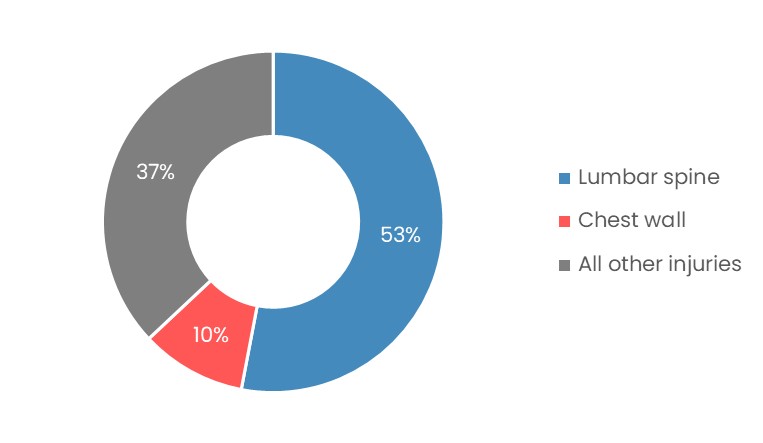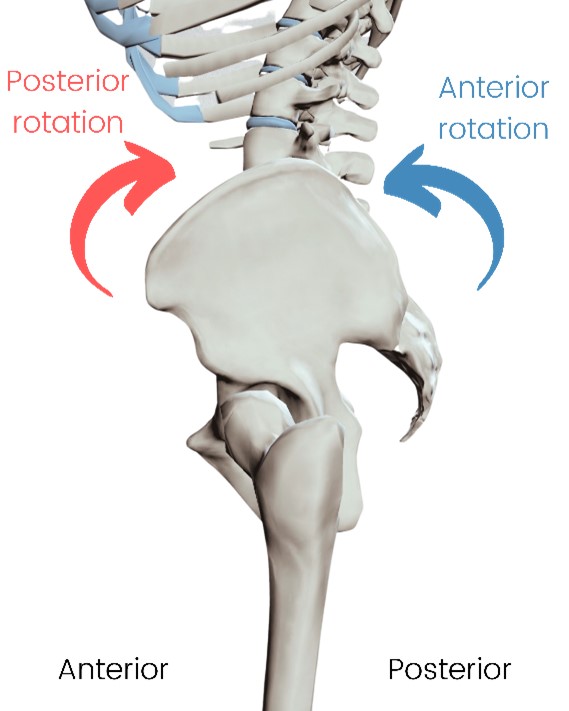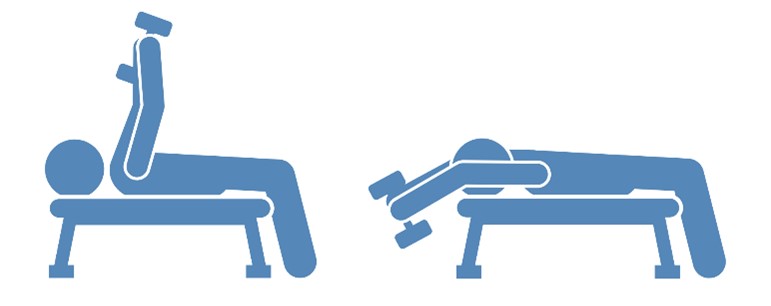What are the common rowing injuries and how can you look to prevent them. Read on…
Rowing injuries are inevitable
One of the hard truths, regardless of level or ability, are rowing injuries. Research has shown 50% of rowing injuries occur on land (Hickey et al 1997). Rowing machine injuries are therefore as likely to occur as on water. Common rowing injuries occur mainly around the low back and the chest wall (ribs stress injuries), but injuries will also occur across the shoulder, knee, hip, wrist, and forearm. Rowing back injuries account for around 53% of all common rowing injuries, with a further 10% being accounted for by the chest wall (Thornton et al 2017). This makes the low back and chest wall the most common rowing injuries. These two rowing injuries will be the main focus, although reference will be made to the remaining identified common rowing injuries.

Figure 1: Distribution of common rowing injuries
Rowing back injuries – the evidence
There is evidence that during a season, rowing back injuries will be experienced by half of all rowers, with this increasing to as much as 65% for junior male rowers (Wilson et al 2021). With rowing back injuries being so prevalent, the natural questions that spring to mind is ‘why are these so common?’ and ‘what can we do about them?’
For those interested in a much deeper dive, a recent consensus paper on preventing and managing rowing back injuries is freely available here (Wilson et al 2021) with World Rowing creating an easier to read version. The One obvious predictor of rowing back injuries is a rower’s previous history. Rowers who have experienced lower back pain previously, are likely to experience it in the future (Ng et al 2014). Interestingly, there is a strong relationship between rowing back injuries and the volume of static ergometer training, specifically sessions lasting greater than 30 minutes (Ng et al 2014). A recent excellent research review of rowing low back pains also highlighted the importance of biomechanics and its relationship to rowing back injuries (Nugent et al 2021). The review found that healthy rowers at the catch had an anterior or neutral pelvic rotation, at the finish had a flat low back position and full knee extension, and greater hip range of movement (Nugent et al 2021). Healthy rowers also had high trunk extensor muscle activity throughout the drive phase (Nugent et al 2021). Rowers who had previous or existing rowing back injuries demonstrated at the catch and finish a posterior pelvic rotation, at the finish greater extension throughout the hips and inefficient muscle activity of the back extensors (Nugent et al 2021). This clearly demonstrates important rowing biomechanics and technique are to reduce the risk of rowing back injuries and specifically rowing machine-caused back injuries.

Figure 2: Anterior and posterior pelvic rotation
Examining this further, rowers are required to get into a deep compression at the catch. This requires excellent range of movement, specifically ankle dorsi-flexion (pulling toes towards the shin), hip internal rotation and flexion and thoracic extension and rotation. Experience has shown when these range of movements are compromised, rowers will still attempt to achieve the catch position but with a compensatory technique, most often a flexion of the lumbar spine and posterior pelvic rotation. This very often results in the occurrence of rowing back injuries. Maintaining an in some cases, increasing range of movement around ankle dorsi-flexion and hip internal rotation and flexion will ensure there is adequate range of movement to achieve the catch position without excessive lumbar spine flexion or posterior pelvic rotation.
Range of movement around these areas is also dependent of force and capacity (strength endurance) capabilities around the hip, trunk, and upper leg. Maximal force capability is required to resist against the forces placed upon the tissues at high loads (lumbar spine can be exposed up to 4.6 times body mass at the catch (Wilson et al 2021). Rowing is a repetitive natured sport which requires a capacity to tolerate repeated loading. With prolonged loading, there will be fatigue in rowing training which may result in spinal creep (Little & Khalsa 2005). Spinal creep is the progressive deformation of the muscles over time when exposed to constant loading. These muscles become less able to exert the same forces over time, resulting in the spine becoming more susceptible to rowing back injuries (Thornton et al 2017). Therefore, rowers also require excellent strength endurance, specifically around the trunk musculature to resist this deformation and therefore, the risk of rowing back injuries.
In deep hip flexion, as experienced within the catch position, the primary hip extensor and stabiliser is the Adductor Magnus and not the Glut Max (Kapandji 2007). The Adductor Magnus are deep muscles located in the inner thighs. Developing the maximal force expression and the capacity to repeatedly load through this tissue will become paramount to ensure adequate hip internal rotation and flexion in the catch position by assisting holding a neutral pelvic position at the catch and resisting the deforming forces of the back extensors places upon the hip and pelvis. The same is true of the Triceps Surae muscle complex, made up of the two heads of the Gastrocnemius and Soleus (the calf muscles) which require excellent maximal force and capacity capability to allow adequate ankle dorsi-flexion range of movement.
As more research around rowing back injuries comes to light, one thing becomes clear. The vast majority of these injuries are a result of a flexion overload of the lumbar spine and will be experienced within the surrounding tissues, whether that is a facet joint strain, disc damage (bulge or herniation) or spondylosis (stress fracture). These are all of a result of a flexion overload and the prevention and rehabilitation requires offsetting this flexion bias as described above. British Rowing have established guidelines to avoid rowing back injuries which provide excellent practical tips to mitigate this risk. World Rowing has also shared an interesting article around what the experts say with regards to rowing back injuries looking at the long term management, mitigation and screening.
Rowing Rib Stress Injuries
Rib stress injuries (RSI) refers to rib overuse injuries (Evans & Redgrave 2016). The ribs themselves do not experience direct loading, so the rowing injury occurs due to the repeated high force contractions of the musculature around the rib cage (Thornton et al 2017). One mechanism of this rowing injury could be the very close timing of peak handle force and high neuromuscular activity of the chest wall and isometric forces of the back extensors (Vinther 2006). This creates rib cage compression whereby the high forces experienced around the musculature resulting in the rib cage compressing and therefore, a potential RSI. Abnormal breathing mechanics whereby postural muscles are utilised to help with respiration may also increase the loading of the rib cage. Experience has also shown that respiratory muscles, such as the Diaphragm and the intercostal muscles may also be used to help stabilise the spine, further increasing the loading of the rib cage, especially under high respiratory stress, such as racing.
One way to mitigate this risk from an RSI rowing injury is for the musculature around the rib cage and to increase the bone mineral density of the ribs themselves to be able to withstand the repeated high-intensity loading. The challenge for many rowers is that the most effective exercises to do this is lifting overhead. This requires a high degree of technical competency to complete as well as having excellent shoulder flexion to be able to lift overhead without hyper-extending the thoracic spine. This hyperextension is a compensatory movement for restrictions in shoulder flexion. However, an alternative exercise than can target these adaptive responses which doesn’t require a high technical competency or limited by range of movement, is the pullover (figure 3).

Figure 3: The pullover exercise
There is a need to ensure appropriate respiration and postural control and utilisation of all trunk and respiratory muscles. Being able to delineate these during high intensity demands requires specific breathing re/training. The completion of trunk strength endurance training may also benefit from incorporating forced breathing strategies whereby the rower takes overexaggerated breaths in and out to ensure the respiratory muscles are not being used for postural control. When looking at the rib cage compression, rowers, and rowing coaches favourite exercise the bench pull needs to be used with caution. Pulling a heavy load towards the chest not only increases the high force muscle contractions around the chest wall but lying prone on a bench increases the compression further. Replacing this exercise with something similar like a seated row can dramatically decrease this risk without losing the desired outcome. You can find out what other coaches and rowers do in this article to mitigate the risk of overuse injuries.
A cautionary note for lightweight rowers who tend to restrict caloric intake to make or maintain weight. Restrictions in energy intake can lead to low bone mineral density and testosterone, further increasing the risk of an RSI rowing injury (Vinther et al 2005).
Additional Common Rowing Injuries
Rowing Shoulder Injuries
The shoulder is the third most common rowing injury site (Thornton et al 2017). The most common issue arises with poor shoulder girdle positioning and stabilisation due to posterior shoulder muscle weaknesses and anterior shoulder muscle overuse, including the neck (Thornton et al 2017). Interestingly, a study of shoulder pain across multiple athlete types showed a relationship between days of training a week, years of training and level of performance with occurrence of pain with rowers having the longest lasting pain (Mohseni-Bandpei et al 2012). Rowing shoulder injury pain maybe experienced more by those at elite level and master rowers. Rowing shoulder injuries can be managed with regular stretching of the anterior shoulder and neck and stabilisation conditioning around the posterior shoulder and upper back.
Rowing Knee Injuries
The knee will go through a full range of movement and experience extremely high compressive forces at the catch. It is very unlikely rowing knee injuries will be traumatic in nature and more likely to be repetitive overloading such as tendinopathy, Iliotibial band friction syndrome (ITBS), or generalised patella-femoral pain syndrome (PFPS). Rowers generally have poor Glut Max and posterior hip and thigh function and mass resulting in poor antagonistic muscle contraction to help dampen the repetitive overload created from the forceful knee extensors, the Quadriceps. To help mitigate these repetitive overloads of the knee, focusing on posterior hip and adductor high force and strength endurance capacity is recommended.
Rowing Wrist Injuries
A rowing wrist injury is most likely to occur due to poor technique of tightly griping the oar or excessive wrist motion while feathering the oar. Similar to rowing knee injuries, these are repetitive overload injuries. Since these are rowing wrist injuries are related to rowing technique, time should be spent in cleaning up the technical errors of gripping tightly of excessive feathering. Those who suffer from such repetitive overload injuries (i.e., exertional compartment syndrome, lateral epicondylitis, tenosynovitis, or intersection syndrome) may benefit from training without feathering or tight grip such as using ergometer.
Rowing Hip Injuries
Can rowing cause hip pain? The prevalence of hip injuries has started to increase, mostly impingement of the head of the femur with the acetabulum of the hip joint or labral tear (cartilage around the rim of the hip socket) which will result in hip pain. Over the last 10 years, experience has highlighted greater improvements in management of rowing back injuries and therefore a decrease in incidents which has coincided with the increase in hip injuries. While there is no direct evidence of this relationship, the inference is that with improvements in maintaining good pelvic and lumbar spine position whereby the compression range of movement at the catch is no longer dependent from lumbar flexion and posterior pelvic rotation. This increases the demand for the range of movement to come from the hip. The compressive catch position requires deep hip flexion and terminal internal rotation. If there are restrictions within either, then there is the risk of the identified rowing hip injuries to occur. If a rowing hip injury occurs, this could eventually result with the lumbar spine having to compensate for this reduced range of movement. It is imperative that time is spent on developing and / or maintaining hip flexion and internal rotation range of movement. While chronic long term changes are desirable, short term changes ahead of rowing is equally as important so including this range of movement based exercise as part of warm ups is also recommended.
Conclusion
While this has explored the majority of common rowing injuries, the greatest burden is most likely to come from rowing back injuries and then rowing chest wall injuries. With the evidence suggesting that half of rowers are likely to experience a rowing back injury during the course of a season, the opportunities outlined should provide the basis in helping to manage this potential risk. Here are some additional general injury prevention pointers which are worth exploring within this article which we can applied immediately. While we cannot totally mitigate all risk of all common rowing injuries, injuries don’t have to be an accepted part of training and competition. By understanding the potential mechanisms of rowing injuries and applying the key points provided, we have a greater chance of managing thee risks and enjoy the freedom of rowing injury free.
Find out how Ludum can identify common signs of overtraining in rowing with injury tracking software.
References
Evans, G. & Redgrave, A. (2016). Great Britain Rowing Team guidelines for diagnosis and management of rib stress injury: part 2. The guideline itself. British Journal of Sports Medicine. 50 (5). 270-272.
Hickey, G. J. et al. (1997). Injuries to elite rowers over a 10-yr period. Medicine and science in Sport and Exercise. 29 (12). 1567-1572.
Thornton, J. S. et al. (2017). Rowing injuries: an updated review. Sports Medicine. 47 (4). 641-661.
Kapandji, I. A. (2007). The Physiology of Joints – Volume 3: The Spinal Column, Pelvic
Girdle and Head. Pencaitland, Scotland, UK: Handspring Publishing.
Little, J. S. & Khalsa, K. (2005). Human lumbar spine creep during cyclic and static flexion: creep rate, biomechanics, and facet joint capsule strain. Annals of Biomedical Engineering. 33 (3). 391-401.
Mohseni-Bandpei, M. et al (2012). Shoulder pain in Iranian elite athletes: the prevalence and risk factors. Journal of Manipulative Physiological Therapeutics. 35 (7). 541–548.
Ng, L. et al. (2014). Self reported prevalence, pain intensity and risk factors for low back pain in adolescent rowers. Journal of Science & Medicine in Sport. 17. 266-270.
Nugent, F. et al. (2021). The relationship between rowing-related low back pain and rowing biomechanics: a systemic review. British Journal of Sports Medicine. 0. 1-15.
Vinther A, et al. (2005). Exercise-induced rib stress fractures: influence of reduced bone mineral density. Scandinavian Journal of Medicine and Science in Sports. 15. 95–99.
Vinther, A. (2008). Rib Stress Fractures in Elite Rowers. Lund: Lund University.
Wilson, F. et al. (2021). 2021 consensus statement for preventing and managing low back pain in elite and subelite adult rowers. British Journal of Sports Medicine. 0. 1-7.
View more content like this

Canadian Olympic Champion Rower and Leading Management Consultant Adam Kreek interviewed in Crossy's Corner
Former Olympic Champion and Executive Business Coach, Adam Kreek shares some of his experiences with Martin Cross. Interestingly both Martin and Adam were coached to
Why monitor Injury and Illness?
In order to maximise an athletes rate of improvement they need to complete as much of the training on testing in programme as possible. Understanding
Crossy Gets Cornered: Our Interview with Olympic Champion and Rowing Legend Martin Cross
In order to maximise an athletes rate of improvement they need to complete as much of the training on testing in programme as possible. Understanding




